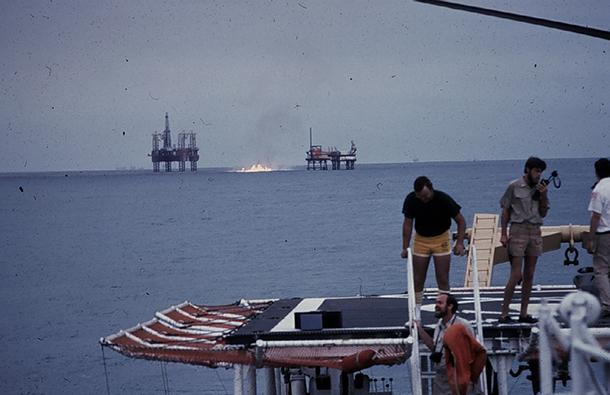Forgotten satellite data is helping researchers reconstruct the effects of a 1979 oil spill
The 1979 Ixtoc oil well blowout from a helicopter platform in the Bay of Campeche, Mexico, is shown here.
A team of US and Mexican researchers examining the 1979 Ixtoc oil spill off the Mexican coastline has been given an exciting new tool: rediscovered satellite data from the 1970s.
The team of US and Mexican researchers is revisiting Ixtoc to find out how the environment nearby has recovered and to learn how the area around the 2010 Deepwater Horizon spill might look in the future. The "digital archaeology" done by two researchers has become an invaluable tool.
Related: Studying a 1979 oil spill may help scientists predict long-term effects of Deepwater Horizon
Deepwater Horizon was measured by multiple satellites, dozens of ships and aircraft. A single satellite image allows researchers to survey the entire Gulf of Mexico in one shot. In the '70s, however, that level of detail wasn’t even a possibility. Back then, it would have taken days or even months, using aircraft, to capture one complete view of the Gulf. Using a boat would have taken years.
But in 1979, a handful of planes and boats were pretty much all first responders had to work with. So, millions of barrels of spilled oil went unaccounted for. What cleanup crews didn’t know was that a few hundred miles overhead, two early satellite instruments were busy clicking away.
One was the Landsat Multispectral Scanner, a sort of orbiting digital camera. The other was the Coastal Zone Color Scanner, or CZCS. Satellites had only recently been launched and few people knew how to use them. Because of their orbits, they didn’t often fly over the Gulf of Mexico. CZCS took measurements of the Gulf just once every four days. The Landsat Scanner took measurements only every 16 days.
Chuanmin Hu, an optical oceanographer at the University of South Florida who uses satellites to study modern oil spills, thought maybe he could extract something useful from the old satellite data. Hu works with Steve Murawski, a professor at USF’s College of Marine Science who helps lead the researchers studying Ixtoc.
If Hu and his team could use the old data to piece together images of the Gulf from 40 years ago, they might be able to make a basic map of where oil traveled during Ixtoc, one that could help Murawski’s team figure out which areas to study first.
So Hu and his students revisited the old satellite files. They’re actually not that hard to get: Just visit the NASA website. “Everybody, not just from this country, but around the world, has access to that data. It’s public domain,” Hu says. “How you process the data, that’s the challenging part.”
It means turning raw data from the satellites into an image, then figuring out which region of the Gulf it’s showing. Then, you’ve got to figure out if there’s any oil in the water, which isn’t always obvious. “The first thing is to look at contrast on the ocean surface. So, any outstanding feature that’s suspicious,” Hu says.
Hu can tell at a glance if an image shows clouds, say, or material floating on the water’s surface, but he can’t easily tell if that material is algae, oil or something else. To do that, he has to analyze the subtle colors of light being reflected and absorbed.
“These well-designed sensors measure the different colors reflected from oil, from nonoil and from other things in the ocean,” Hu says. “And they each have a different color shade measured by the sensor. Oil has a different shade than others, although your eyes can barely tell the difference.”
Hu’s graduate student, Shaojie Sun, pored over all the data and slowly figured out which measurements showed oil, instead of clean seawater. Over the course of a few months, he squeezed out enough information to make a map of the Gulf of Mexico — and the first map ever created of the Ixtoc spill — nearly four decades after the well was plugged.
“It’s really exciting to map out a 40-year-old oil spill,” Sun says. “[Now], other scientists can use my map, and my work, to do their own science.”
Murawski says Sun’s work is a gold mine.
“We looked at the map that we got from the satellite imagery as a treasure map,” Murawski says. “It has basically told us where to look for concentrations of oil, both on the bottom and in the shoreward areas … It’s incredibly valuable from a scientific point of view.”
Murawski says Sun and Hu have created something entirely new: a tool that lets scientists revisit the past.
“The new map gives us not only a mosaic of what happened over nine months, so we can see the full footprint, but it also gives us some time slices of how that oil spill evolved over time,” he says.
The joint US-Mexican team is using Sun's and Hu’s map to plan out where to take samples along the Mexican coast. They’re pulling bits of mud from the seafloor, collecting worms and other creatures living there, and they’re analyzing the water surrounding them, all based on the guidance they’re getting from 40-year-old satellites.
What they find now will help them understand the impact of Deepwater Horizon four decades into the future and tell whether the next generation of Gulf residents will still be feeling its effects.
This article is based on a story that aired on PRI’s Living on Earth with Steve Curwood.
